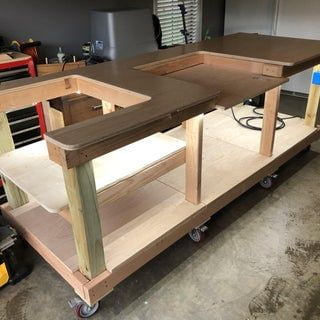Woodworking is a timeless craft that has captured the imagination of people for centuries. From exquisite furniture pieces to intricate carvings, the art of transforming wood into beautiful and functional creations is both mesmerizing and rewarding. As our society becomes more technology-driven, there has been a resurgence in the popularity of woodworking as a way to reconnect with nature and unleash one’s creativity.
In today’s fast-paced world, many individuals are seeking ways to escape the digital realm and engage in activities that allow them to work with their hands and create something tangible. Woodworking provides this perfect outlet through its tangible and tactile nature. It offers a reprieve from the virtual world, allowing individuals to immerse themselves in the physicality of working with wood.
The growing popularity of woodworking can also be attributed to its accessibility. With advancements in technology, tools, and resources, it has become easier than ever for beginners to embark on their woodworking journey. Whether you’re a complete novice or have some previous experience, there are numerous avenues available for learning and honing your skills.
As we delve deeper into this fascinating world, we will explore different aspects of woodworking such as understanding its various types, equipping yourself with essential tools, overcoming common challenges, finding resources for learning and growth, and even considering whether you want woodworking to remain a hobby or pursue it professionally.
Join us on an exploration of this captivating craft as we uncover the joys, rewards, and personal growth that come from embracing woodworking.
The Basics
Woodworking is a diverse craft that encompasses various techniques and styles. Understanding the different types of woodworking is essential for aspiring woodworkers to choose their preferred niche within the field. Here, we will explore the basics of each type of woodworking:
- Furniture Making: This type of woodworking focuses on creating functional and aesthetically pleasing pieces of furniture such as chairs, tables, cabinets, and beds. It involves working with a variety of tools and techniques like joinery, carving, and shaping.
- Cabinetry: Cabinetry woodworking is centered around building custom-made cabinets for kitchens, bathrooms, or any other area that requires storage solutions. It requires precision cutting, fitting doors and drawers, and creating decorative elements to enhance the overall design.
- Woodturning: This technique involves shaping wood using a lathe to create symmetrical cylindrical forms like bowls, vases, and spindles. Woodturning requires specialized tools like chisels and gouges to shape the wood while it rotates on the lathe.
- Fine Woodworking: Fine woodworking emphasizes intricate details and craftsmanship in creating high-quality wooden objects like jewelry boxes, musical instruments, or intricate decorative pieces. It often involves the use of delicate hand tools for precise cuts and meticulous joinery techniques.
- Carpentry: Although often seen as a separate discipline from woodworking, carpentry relies heavily on woodworking skills to construct structures such as houses, buildings, or frameworks. Carpenters utilize various power tools to measure accurately and cut lumber for construction purposes.
Understanding these different types of woodworking allows beginners to determine which area they are most interested in pursuing further. Each type requires specific skills and tools that can be developed over time through practice and experience. Whether you prefer creating functional furniture or experimenting with intricate designs, there is a branch of woodworking suited to your interests and talents.
Tools of the Trade
Woodworking is a craft that requires a variety of tools to bring your creations to life. Having the right tools is essential for achieving precision, efficiency, and safety in your woodworking projects. In this section, we will explore the essential woodworking equipment that every aspiring woodworker should have in their workshop.
Hand Tools
Hand tools are an integral part of woodworking and offer more control and precision compared to power tools. Some essential hand tools include:
- Chisels: Used for carving, shaping, and cutting wood.
- Hand saws: Ideal for making straight cuts or crosscuts.
- Planes: Used to smooth the surface of the wood.
- Hammers and mallets: Essential for driving nails, chiseling, or tapping delicate pieces together.
Power Tools
Power tools can help increase productivity and speed up your woodworking projects. While there are countless power tools available, some fundamental ones are:
- Circular saw: Perfect for making accurate straight cuts.
- Router: Used for decorative edge shaping or creating joinery.
- Drill press: Essential for drilling precise holes at various depths.
- Random orbital sander: Ideal for smoothing rough surfaces without leaving visible marks.
Safety Equipment
Woodworking involves working with sharp tools and potentially dangerous machinery. It is crucial to prioritize safety and protect yourself from potential hazards in the workshop. Here are some necessary safety equipment items:
- Safety glasses or goggles: Protects your eyes from flying debris.
- Hearing protection: Guards against loud noises produced by power tools.
- Dust mask or respirator: Prevents inhalation of harmful dust particles.
- Work gloves: Provides a layer of protection when handling sharp objects.
It’s important to note that while investing in quality tools is essential, you don’t need to break the bank right away. Start with a few basic tools and gradually expand your collection as you progress in your woodworking journey. Remember to always prioritize safety, proper tool maintenance, and continuous learning to make the most of your woodworking experience.
Starting from Scratch
Woodworking is a versatile and rewarding craft that allows individuals to create beautiful and functional pieces out of wood. Whether you have always been fascinated by woodworking or are simply looking for a new hobby to explore, starting from scratch as a complete beginner can be an exciting and challenging journey. This section will provide a step-by-step guide on how to begin woodworking as a novice, including essential tips and techniques to help you get started.
Setting Up Your Workspace
Before diving into the world of woodworking, it is important to set up a dedicated workspace where you can safely work on your projects. A garage, basement, or even a small corner in your home can be transformed into a functional workshop. Ensure that you have adequate lighting, ventilation, and organization systems in place for your tools and materials.
Investing in Essential Tools
To begin your woodworking journey, it is necessary to invest in the essential tools required for the craft. Some basic tools include a workbench or sawhorse for supporting your projects, measuring tools such as a tape measure and combination square, hand saws for cutting wood, chisels for shaping wood surfaces, and clamps for holding pieces together. As you progress in your skills and undertake more complex projects, you can gradually add more specialized tools to your collection.
Starting with Simple Projects
As a beginner woodworker, it is advisable to start with simple projects that help you practice foundational skills while building confidence. Begin by working with softwoods like pine or spruce before venturing into more expensive hardwoods. Simple projects such as building a birdhouse or a small shelf can teach you the basics of measuring, cutting, drilling holes, and joining pieces together. As you become comfortable with these fundamental techniques, gradually challenge yourself by taking on more complex projects.
By following these steps and seeking out resources such as books or online courses for beginners, you can embark on your woodworking journey with confidence and enthusiasm. Remember that woodworking is a skill that takes time and practice to master, so do not be discouraged by early mistakes or challenges. With persistence and dedication, you will gradually cultivate the skills and techniques required to create beautiful woodwork pieces and unlock your inner craftsmanship.
How Hard Is It to Master Woodworking Techniques? Unleashing Your Inner Craftsmanship
Woodworking is an art form that requires patience, practice, and a willingness to learn. While the initial stages of woodworking may seem daunting, with time and dedication, mastering woodworking techniques is achievable for anyone with a passion for craftsmanship. In this section, we will explore the challenges faced by aspiring woodworkers and how they can overcome them to unleash their inner craftsmanship.
Developing Skills through Practice
One of the key aspects of mastering woodworking techniques is consistent practice. Woodworking is a skill that improves with time and experience. Starting small and gradually working on more complex projects allows beginners to develop their skills at their own pace. It is important to understand that mistakes are part of the learning process in woodworking, and each mistake presents an opportunity to learn and grow.
Understanding Wood Properties
Woodworking involves working with different types of wood, each having its unique properties and characteristics. Understanding these properties is crucial in determining which type of wood would be best suited for a particular project. A thorough knowledge of wood species, grain patterns, strength, and flexibility will aid in executing woodworking techniques effectively and enhance the finished product.
Continuous Learning
Woodworking techniques are vast and diverse, ranging from carving to joinery to finishing techniques. Mastering all these techniques requires continuous learning throughout one’s woodworking journey. Seek out resources such as books, online courses, and communities dedicated to woodworking where you can gain valuable insights from experienced craftsmen. Engaging in workshops or apprenticeships can also provide hands-on learning opportunities under the guidance of seasoned professionals.
Overcoming Challenges
Woodworking, like any craft, comes with its fair share of challenges. While it may seem daunting at first, many woodworking enthusiasts find that the satisfaction and fulfillment they get from creating something with their own hands outweighs the difficulties they encounter along the way. In this section, we will explore some common difficulties faced by woodworking enthusiasts and provide tips on how to overcome them.
One of the primary challenges in woodworking is learning how to use different tools properly. Each tool has its own specific purpose and technique, and mastering them can take time and practice. For beginners, understanding how to safely operate power tools like saws and drills can be intimidating. It is essential to start with simpler tools and gradually work your way up as you gain confidence and proficiency.
Another difficulty encountered by woodworking enthusiasts is working with imperfect wood or dealing with mistakes during a project. Wood is a natural material that can have various flaws such as knots, warps, or cracks. These imperfections can pose challenges when trying to achieve precise measurements or smooth surfaces. Additionally, mistakes are bound to happen in woodworking, such as inaccurate cuts or assembly errors. However, these setbacks should not discourage you; instead, view them as opportunities for growth and learning.
Time management is another obstacle that many woodworking enthusiasts face. Woodworking projects can be time-consuming due to the attention to detail required in measuring, cutting, sanding, and finishing each piece. It is crucial to plan your projects carefully and set realistic goals for yourself based on your available time and skill level. Breaking down larger projects into smaller tasks can help you stay organized and prevent feeling overwhelmed by the amount of work involved.
Resources for Aspiring Woodworkers
The world of woodworking can be an exciting and fulfilling hobby or profession to pursue. Whether you are just starting out or have been honing your skills for years, it is always valuable to have access to resources that can help you grow and expand your knowledge in the field. In this section, we will explore some of the best books, online courses, and communities available for aspiring woodworkers.
One of the most recommended books for those looking to dive into woodworking is “The Anarchist’s Tool Chest” by Christopher Schwarz. This book offers a comprehensive guide to building a well-rounded set of hand tools and provides valuable insights on how to use them effectively.
Another popular choice is “The Complete Manual of Woodworking” by Albert Jackson and David Day. This book covers everything from basic techniques to advanced furniture-making, making it an excellent resource for woodworkers at any level.
When it comes to online courses, there are various platforms that offer comprehensive woodworking lessons. One highly regarded platform is FineWoodworking.com, which offers a range of video tutorials taught by experts in the field. The site covers topics such as joinery, finishing techniques, and even project plans for different skill levels. Another reputable option is Udemy.com, where you can find courses specifically tailored to beginners or more advanced woodworkers.
In addition to books and online courses, joining a woodworking community can provide invaluable opportunities for learning and networking with fellow enthusiasts. Websites like WoodTalkOnline.com offer forums where members can ask questions, share their projects, and receive feedback from experienced woodworkers. Local woodworking clubs and organizations also organize workshops and events where you can learn new techniques alongside like-minded individuals.
| Resource | Description |
|---|---|
| “The Anarchist’s Tool Chest” by Christopher Schwarz | A guide to building a well-rounded set of hand tools and using them effectively. |
| “The Complete Manual of Woodworking” by Albert Jackson and David Day | Covers everything from basic techniques to advanced furniture-making. |
| FineWoodworking.com | Online platform with video tutorials taught by experts in the field. |
| Udemy.com | Offers courses specifically tailored to beginners or more advanced woodworkers. |
| WoodTalkOnline.com | An online forum for woodworkers to ask questions, share projects, and receive feedback. |
By utilizing these resources, aspiring woodworkers can gain valuable insights, learn new techniques, and become part of a supportive community that can enhance their woodworking journey. Whether you prefer books, online courses, or connecting with fellow enthusiasts, there are numerous options available to help you develop your skills and take your woodworking to new heights.
Woodworking as a Hobby vs. Pursuing it Professionally
Woodworking is not only a practical skill but also a creative outlet that allows individuals to express their craftsmanship. Whether you are a beginner or have some experience with woodworking, one important decision to make is whether to pursue it as a hobby or take it up professionally. This section will discuss the factors you should consider when deciding between woodworking as a hobby or pursuing it as a professional career.
First and foremost, it’s essential to assess your level of commitment and passion for woodworking. Pursuing woodworking professionally requires a significant investment of time, effort, and resources.
It often involves establishing a workshop, obtaining necessary tools and materials, and continuously honing your skills through practice and education. On the other hand, if you see woodworking as something you enjoy doing in your spare time and don’t want the pressure of turning it into a business or career, then pursuing it as a hobby might be more suitable for you.
Another factor to consider is financial stability. Woodworking as a profession can be financially rewarding if done right. Skilled woodworkers often have the opportunity to sell their creations, take custom orders, or even work on commissioned projects.
However, building a successful woodworking business takes time and effort, especially in terms of marketing, networking, and acquiring clients. If financial stability is crucial for you and you are willing to put in the necessary work to turn your passion into profit, pursuing woodworking professionally may be worth considering.
Lastly, think about how much time you can dedicate to woodworking. If you have other commitments such as a full-time job or family responsibilities that demand most of your time and attention, pursuing woodworking professionally may not be feasible. In such cases, treating woodworking as a hobby allows you the flexibility to indulge in this craft at your own pace and leisure.
| Factors to Consider | Woodworking as a Hobby | Pursuing Woodworking Professionally |
|---|---|---|
| Level of commitment and passion | Enjoy woodworking without the pressure of turning it into a business or career | Dedicate time, effort, and resources to establish a successful woodworking business |
| Financial stability | No expectations of financial rewards or profits | Potential for financial rewards through selling creations, custom orders, or commissioned projects |
| Time availability | Flexibility to indulge in woodworking at your own pace and leisure | Requires a significant time commitment for practice, education, marketing, networking, and acquiring clients. |
Ultimately, the decision between woodworking as a hobby or pursuing it professionally depends on your personal goals, lifestyle, and circumstances. Both paths offer their own unique advantages and challenges. Regardless of which path you choose, embracing woodworking is sure to bring fulfillment and a sense of achievement as you work with your hands to create beautiful pieces from wood.
The Joy of Creating
Woodworking is more than just a craft or a hobby – it is a journey that offers numerous rewards and benefits to those who embark on it. One of the greatest joys of woodworking is the ability to create something with your own hands. Whether you are building furniture, carving intricate designs, or crafting functional items, there is a unique sense of satisfaction in seeing your vision come to life through the transformation of raw materials into a finished piece.
The process of woodworking also provides therapeutic benefits for many individuals. The act of working with wood and engaging in repetitive tasks such as measuring, cutting, and shaping can be incredibly calming and soothing to the mind. It allows for a meditative state in which one can focus solely on the present moment and let go of any worries or stress. Woodworking has been known to reduce anxiety, improve mental clarity, and promote overall well-being.
Furthermore, woodworking fosters an appreciation for craftsmanship and tradition. In an era dominated by mass-produced goods, there is something special about creating handmade items that showcase skill, attention to detail, and dedication to the craft. Woodworking allows individuals to connect with time-honored techniques and preserve traditional craftsmanship while adding their personal touch.
Moreover, woodworking offers endless opportunities for learning and personal growth. As you work on various projects and tackle new challenges, you will inevitably acquire a wealth of knowledge about different wood species, joinery techniques, tool usage, finishing methods, and design principles. This continuous learning process not only improves your woodworking skills but also enhances problem-solving abilities and cultivates perseverance.
Conclusion
Woodworking is a fascinating craft that has experienced growing popularity in recent years. From understanding the different types of woodworking to acquiring the essential tools, starting as a complete beginner may seem daunting at first. However, with dedication and perseverance, anyone can master woodworking techniques and unleash their inner craftsmanship.
While woodworking does present its fair share of challenges, such as mastering intricate joinery or dealing with wood movement, these obstacles should not discourage aspiring woodworkers. In fact, overcoming these difficulties only adds to the sense of accomplishment and satisfaction that comes with completing a project. With the wide array of resources available, including books, online courses, and communities, aspiring woodworkers have access to valuable guidance and support throughout their journey.
Whether you choose woodworking as a hobby or pursue it professionally, it is important to make the decision that aligns with your goals and aspirations. Woodworking as a hobby offers creative expression and an opportunity for self-discovery. On the other hand, pursuing it professionally provides a path for those looking to turn their passion into a career. Whichever path you choose, woodworking offers countless rewards and benefits.
In conclusion, embracing the journey of woodworking is not just about acquiring skills and creating beautiful pieces; it is also about personal growth within the craft. As you navigate through the different stages of learning and face challenges along the way, you will develop patience, problem-solving abilities, and an eye for detail.
The joy that comes from turning raw materials into something functional and beautiful is unparalleled. So go ahead – pick up those tools and start your own woodworking adventure today.
Frequently Asked Questions
How do I get into woodworking with no experience?
Getting into woodworking with no prior experience may seem intimidating, but it is definitely possible and can be an incredibly rewarding journey. To start, educate yourself by reading books or watching online tutorials that provide a foundation of woodworking knowledge and techniques. Consider joining a local woodworking club or taking a beginner’s course to gain hands-on experience and learn from experienced woodworkers.
Investing in basic tools like a saw, chisel set, and measuring tools is essential, but starting small with simple projects will help you build confidence and skills over time. Remember to be patient with yourself and embrace the learning process as you gradually develop your abilities in this fulfilling craft.
How long does it take to learn woodworking?
The length of time it takes to learn woodworking varies depending on multiple factors such as the level of commitment, the amount of time invested regularly, and the complexity of projects pursued. It is important to approach woodworking as a continuous learning process rather than expecting to become a master overnight. With consistent practice and dedication, one can become proficient in fundamental techniques within months or even less depending on individual progress.
However, mastering more advanced skills can take several years or even decades. Embrace the journey of learning, celebrate each milestone reached along the way, and enjoy the satisfaction that comes with honing your woodworking skills.
Is woodworking as a hobby worth it?
Woodworking as a hobby has numerous benefits that make it worth pursuing for many individuals. First and foremost, it allows for creative expression by transforming raw pieces of lumber into beautiful and functional objects like furniture or decorative items tailored to your personal tastes. Woodworking also offers an escape from daily stress as it immerses you in a world where focus and attention to detail are required – providing relaxation and mindfulness during the crafting process.
Moreover, it brings a sense of accomplishment when completing projects that you can admire or share with friends and family. Additionally, woodworking provides an opportunity for personal growth as you constantly challenge yourself to learn new techniques and acquire problem-solving skills along the way. Ultimately, the joy of working with your hands and creating something tangible from scratch makes woodworking a highly rewarding hobby.

Hi everyone! I’m a woodworker and blogger, and this is my woodworking blog. In my blog, I share tips and tricks for woodworkers of all skill levels, as well as project ideas that you can try yourself.





